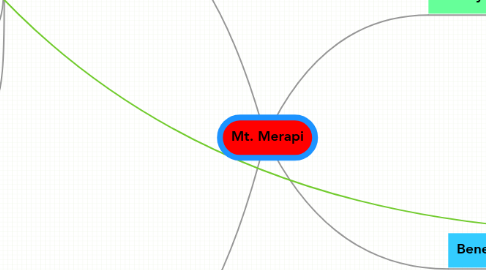
1. People
1.1. There are 3000 people living at Yogyakarta at the foot of Mt. Merapi
1.1.1. Why do they want to live there?
1.1.2. How do they adapt?
1.1.2.1. Farmers cut the slopes into stepped flat lands called terraces
1.1.2.1.1. They then flood it to gorw rice crops.
1.1.2.2. For emergencies
1.1.2.2.1. Transport is made available for people to flee the area in case of volcanic eruptions.
1.1.2.2.2. A volcanic map has been drawn that guides people in deciding where to build their homes
1.1.2.2.3. Shelters are built to offer protection against volcanic ash in times of eruption.
1.1.2.2.4. Masks has been distributed to people living near Mt. Merapi.
1.2. Many people around the world travel to see Mt. Merapi
1.2.1. Spectacular Scenery like
1.2.1.1. Lava Fountains
1.2.1.2. Its eruptions
1.2.2. Locals also earn money from providing services like
1.2.2.1. Conducting guided tours
1.2.2.2. Trekking trips up the volcano
1.3. The government
1.3.1. They hire volcanologists to monitor volcanic activity on Mt. Merapi.
1.3.1.1. One method is to collect gas samples
1.3.1.1.1. It is risky, but an important monitoring technique used.
2. Dangers
2.1. Volcano could erupt any time
2.1.1. People could die
2.1.2. Homes will be destroyed
2.1.3. Crops and livelihoods will be ruined.
2.2. When it erupts, a huge quantity of volcanic ash is released into the atmosphere.
2.2.1. The ash can hit areas as far as 100 km away, affecting even people living far away from the volcano.
2.2.2. Ash could cause:
2.2.2.1. Breathing Difficultues
2.2.2.2. Skin diseases
2.2.2.3. Diarrhoea
2.2.2.4. Serious eye infections
2.3. When it erupts,
2.3.1. Destruction of building and roads
2.3.2. Fires caused by lava flowing across people's homes
2.3.3. Destruction of land used for farming and a loss of livelihood for farmers
2.4. Craters of Mt. Merapi is still emmitting smoke.
2.4.1. A possible major eruption in the future may occur.
3. History
3.1. Mt. Merapi is in Indonesia
3.1.1. Lies along Pacific Ring of Fire
3.1.2. Country with most number of active volcanoes in the world
3.1.2.1. 130 volcanoes
3.1.2.1.1. 76 active
3.1.2.1.2. 54 dormant/extinct
3.2. Merapi's name
3.2.1. Meru--> Mountain
3.2.1.1. Merapi = "Mounrain of Fire"
3.2.2. Api-->Fire
3.3. Mt. Merapi has experienced 68 volcanoes since 1548.
3.3.1. Violent eruptions killed over 1000 people in 1930.
3.3.2. In 1979 Lava poured down on several nearby villages, taking 149 lives.
3.3.3. In 1995, an eruption killed 30 people and injured 100.
4. Benefits
4.1. Fertile soil at the foot of Mt. Merapi.
4.1.1. Every time Mt. Merapi erupts, a huge amount of volcanic ash is released. It makes the soil fertile and helps crops to grow well.
4.2. If people were to move to other areas, they may not find soil as fertile as this.
4.2.1. They mainly grow rice, soya beans and peanuts.
